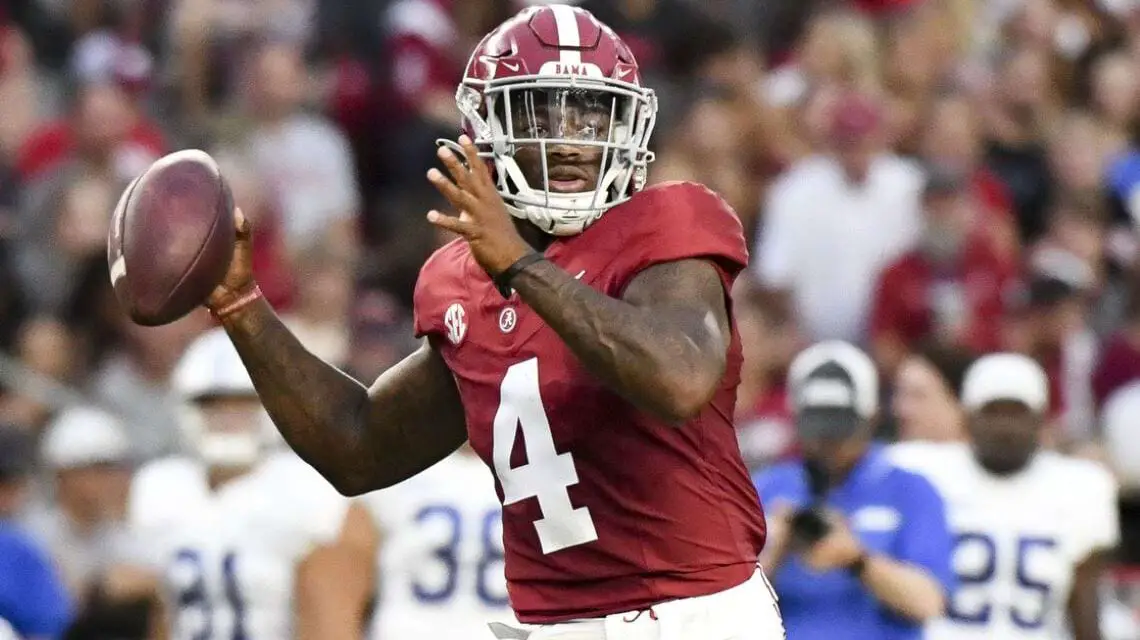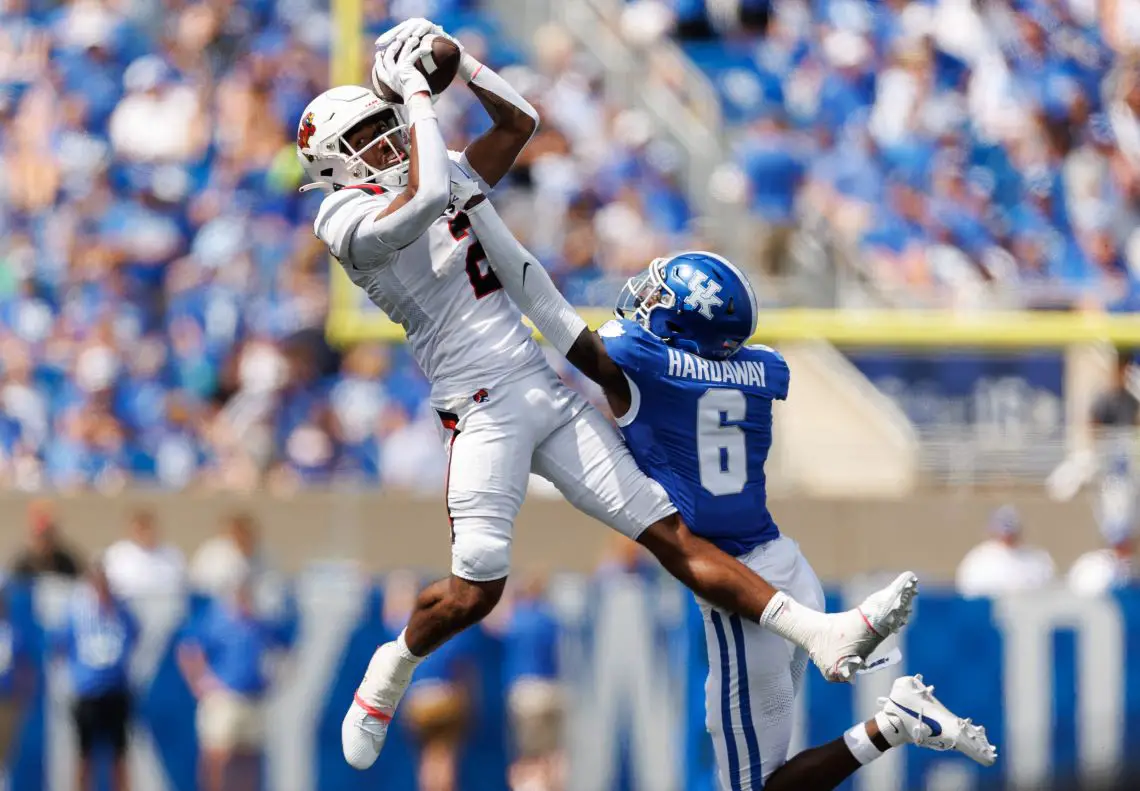
Gary Cosby Jr./USA TODAY Sports
One play changed football forever.
The sport was once played very differently. But after the introduction of the forward pass, football took a new direction.
Forward passes did much more than simply bring a new element to the sport. They also affected player safety, made for more exciting touchdowns, expanded the role of the quarterback and much more.
While these changes happened well over a century ago, the ripple effects are still seen today.
The history of the forward pass in football
Gridiron football, also known as American football, originally developed from soccer and rugby. Players were originally only permitted to kick or bat the ball, but they couldn’t pick it up. However, the rules weren’t always consistent from one league to the next.
In 1873, three Eastern college football teams — Yale, Princeton and Rutgers — formed the Intercollegiate Football Association (IFA). Harvard and Columbia would later join and assist in developing a code of rules. Forward passes weren’t allowed yet, although they were sometimes attempted illegally in games. For example, Walter Camp threw a forward pass for Yale in an 1876 matchup against Princeton.
When did football allow the forward pass?
In its early years, football was dominated by rugby-style play. Games were often brutal for the players due to dangerous tackles and very little protective equipment being worn. There were 18 deaths and 159 serious injuries in football games in 1904 alone.
Some wanted to ban the game permanently, citing its violent and potentially deadly nature. A number of colleges and high schools even dropped the sport from their athletic programs.
It wasn’t until 1906 that forward passes were permitted in gridiron football, and the change was directly influenced by the increasing number of deaths and injuries on the field.
President Theodore Roosevelt is often credited with saving the game. Although he was a big fan of the sport’s roughness, he recognized that reform was needed to prevent dangerous outcomes. He brought representatives from the teams at Harvard, Princeton and Yale to the White House in 1905 and encouraged them to change the rules in favor of improved player safety on the field.
An intercollegiate conference, which would later become the National Collegiate Athletic Association (NCAA), made some major rule changes to the sport as a result of the growing protests against football’s brutality. The 1906 season was the first year for the new football rules to go into effect, including the legalization of forward passes.
When was the forward pass invented?
According to the new rules, any player could pass behind the line of scrimmage. However, players weren’t allowed to throw or catch the ball within five yards of the line of scrimmage. In addition, there were only two ends who were eligible receivers. If a pass hit the ground, it resulted in a turnover.
A number of coaches, players and fans weren’t in favor of these new rules, particularly those from the East Coast. Some believed that forward passes would ruin the game’s legacy in America and make it a less masculine sport. Others felt that the restrictions on legal forward passes were so extreme that few teams would even attempt them. The latter viewpoint was even mentioned in an editorial in The New York Times.
But one team was eager to incorporate forward passes into their game. Eddie Cochems, the head coach for Saint Louis University, spent much of the pre-season drilling his team in forward passes.
Cochems’ efforts were a success. On September 5, 1906, St. Louis University completed the first legal forward pass in their opening game of the season against Carroll College.
Who invented the forward pass?
Bradbury Robinson was the player who threw the first forward pass for St. Louis University, which ultimately hit the ground untouched and led to a turnover.
Although that first attempt wasn’t advantageous for the team, Robinson later made a successful 20-yard touchdown pass. St. Louis University went on to win the game 407-11.
The first pass in a professional football match was made less than two months after this historic game on October 25, 1906. The pass was thrown by George “Peggy” Parratt, who played for the who played for the Massillon, Ohio Tigers, in a game against a team from West Virginia.
Further changes to the forward pass rules
The first legal forward pass on September 5, 1906 was only the beginning. It took several years for football to fully embrace the aerial game.
There were still many fatalities on the field every year. Over time, the rules committee made some modifications to make passing a more attractive strategy for teams. For example, untouched throws that hit the ground were no longer counted as turnovers.
A major shift in the sport finally came in 1913 in a college game between Notre Dame and the Army. Gus Dorais made 14 of 17 passes in that game, including a 40-yard touchdown pass to Knute Rockne. In all, Dorais threw for 243 yards in a noteworthy victory for Notre Dame.
What is a forward pass in football?
Although the running game was, and continues to be, an essential part of football, the passing game became just as essential over the course of the 20th century. New rules were eventually incorporated in order to help protect quarterbacks. Considering their influential contributions to their teams, some of the most famous Football Hall of Fame members, recipients of All-American honors and winners of the Heisman Trophy (named for Georgia Tech coach John Heisman) are National Football League (NFL) and college football quarterbacks.
But what defines a forward pass has changed as the game has evolved throughout football history. Today, a legal forward pass must adhere to these essential rules:
- The offensive team may make one forward pass during each down.
- The ball must move forward toward the opponent’s goal line after leaving the passer’s hands.
- The ball must be passed from behind the line of scrimmage. If the ball goes over the line and comes back behind it, no pass can be made.
- If a player makes any intentional forward movement of his hand or arm with the ball firmly in his control to pass it forward toward the neutral zone, it officially starts the forward pass.
- No center, tackle, or guard may receive a forward pass. Unless that player discloses the intent to the referee before the play is made, that player is an ineligible receiver.
- Tight ends and wide receivers are the only linemen eligible for a forward pass.
- Quarterbacks are the primary players regulated to throw a forward pass.
What does an illegal forward pass in the NFL result in?
If a player makes an illegal forward pass, their team is penalized with a loss of five yards. In addition to the yardage loss, the penalty may include a loss of a down.
What are the advantages of a forward pass?

Jordan Prather/USA TODAY Sports
When the forward pass was first introduced, it opened up a new style of play. Passes were relatively short at first, but longer passes eventually became a common part of the game.
Quarterbacks and receivers became more and more integral to the sport as the passing game increased in popularity. Even the shape of the ball was changed to a narrower shape from the original rugby-style ball in order to accommodate passing plays.
The introduction of forward passing in football resulted in a number of benefits that made football a more exciting and dynamic sport. It infused more speed and skill into a game that had been almost solely focused on brute strength and hard hits.
In addition, passing plays in football also opened up the game in ways that few people could have foreseen. Forward passes led to more of the field being used, which forced defenders to spread out in coverage. The ball can also move much more quickly down the field from the first down when passes are strategically used.
Player safety has also improved dramatically since the early days of football. Although serious injuries can still happen, they are much less common than before the introduction of forward passes.
Why are forward passes used so often in football?
Passing yardage is a major factor in football statistics. That’s because passing plays are used frequently in football for all of the advantages mentioned above. It’s not enough to excel in tackling, running the ball and punting. Today, teams must have strong passing abilities in order to remain competitive.